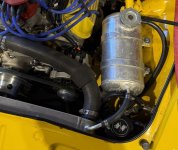KettleCarver
Gold forum user
- Messages
- 262
A little background on the car:
260V8 freshly rebuilt with mild street performance cam. Shorty oil filter installed. Running stock exhaust manifold and Edelbrock F4B intake with a 4 barrel carb.
Has a new Sunbeam Specialties water pump.
6 blade flex fan.
Spal electric fan with Hayden fan controller.
160 degree thermostat
Horn holes blocked.
50/50 coolant mixture with 1 bottle of water-wetter added.
Stock shroud installed.
Stock hood
Rebuilt gauges, which are pretty accurate
13 lb radiator cap
Griffin Aluminum Radiator
The car overheated badly before the rebuild. I could not drive more than 2 miles before it would overheat and boil inside the radiator. The coolant passages had a lot of gunk in them.
After the rebuild the car runs much cooler. I am able to drive 35 - 40 miles and about 40 minutes, with the car reading mostly around 200 on the temp gauge, 210 at the highest. I have confirmed the temps at the thermostat after I stop at between 195 and 205 ( varies after several different drives) using an I/F gun. I have burped the system 3 times and got quite a bit of air out of it each time.
So the car runs at an acceptable temperature while driving and at a stop right after the drive. After a few minutes parked in the garage, I can hear the coolant boiling up in the over-flow tank. The electric fan comes on for short while to cool the radiator. However that is not doing anything to cool the fluid in the over-flow tank.
Anyone have ideas on why this thing boils on the overflow tank only after stopping the engine?
Thanks!
260V8 freshly rebuilt with mild street performance cam. Shorty oil filter installed. Running stock exhaust manifold and Edelbrock F4B intake with a 4 barrel carb.
Has a new Sunbeam Specialties water pump.
6 blade flex fan.
Spal electric fan with Hayden fan controller.
160 degree thermostat
Horn holes blocked.
50/50 coolant mixture with 1 bottle of water-wetter added.
Stock shroud installed.
Stock hood
Rebuilt gauges, which are pretty accurate
13 lb radiator cap
Griffin Aluminum Radiator
The car overheated badly before the rebuild. I could not drive more than 2 miles before it would overheat and boil inside the radiator. The coolant passages had a lot of gunk in them.
After the rebuild the car runs much cooler. I am able to drive 35 - 40 miles and about 40 minutes, with the car reading mostly around 200 on the temp gauge, 210 at the highest. I have confirmed the temps at the thermostat after I stop at between 195 and 205 ( varies after several different drives) using an I/F gun. I have burped the system 3 times and got quite a bit of air out of it each time.
So the car runs at an acceptable temperature while driving and at a stop right after the drive. After a few minutes parked in the garage, I can hear the coolant boiling up in the over-flow tank. The electric fan comes on for short while to cool the radiator. However that is not doing anything to cool the fluid in the over-flow tank.
Anyone have ideas on why this thing boils on the overflow tank only after stopping the engine?
Thanks!

